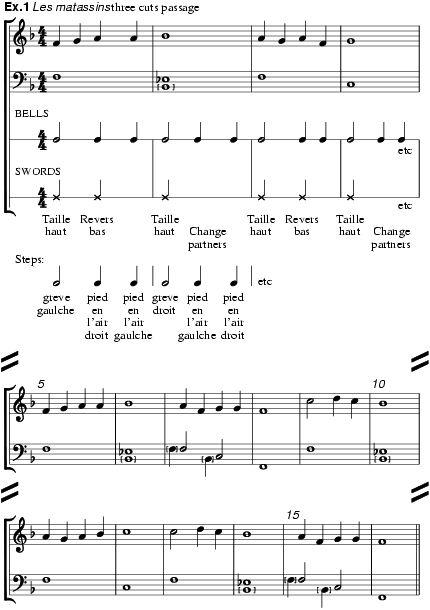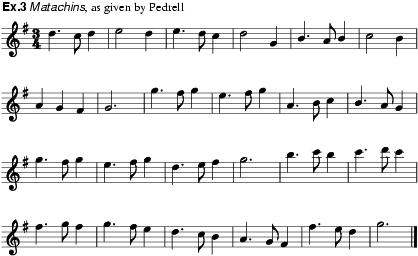
(Fr. matassins; It. mattaccino, mattaccinata; Sp. mattachino; Sp. Amer. matachines).
A figured battle dance for a team of men. The term may derive from the Spanish matar (‘to kill’) or the Italian matta (‘buffoon’); another, less plausible theory suggests Moorish origins and a relation to the Arabic mutawajjihin (‘maskers’ or ‘masks’). The dance reached the height of its popularity in Europe from the 16th century to the 18th and from there spread to Mexico and Spanish-speaking America; it is still performed there and in southern Europe. There seem to have been two distinct types, both usually involving a mock combat and both performed for show rather than as social dances. In one case it was a grotesque dance of ‘fools’ and in the other a skilfully simulated sword fight danced by young noblemen before an aristocratic audience; in parts of Europe it also became a ritual dance, either as a Dance of death or to celebrate church feasts.
References to the grotesque aspects of the matachin abound. Alcocer (in J. Corominas, Diccionario … de la lengua castellana, 1599) referred to ridiculous disguises and grimaces associated with it, and Negri (Le gratie d'amore, 1602) mentioned his mattaccinata of 1572 performed by dwarfs with cudgels and shields. Juan de Esquivel Navarro (Discursos sobre el arte del dançado, 1642/R) referred to the awkward bent knees of a mattachino, The Real Academia Española (Diccionario de la lengua castellana, iv, 1734) included in its definition of the dance a mention of the traditional bladders used by clowns, and Molière, in his comédie-ballet Monsieur de Pourceaugnac (1669), called for six ‘matachins, with syringes’, and two grotesque doctors to attack the comic hero in a wild ballet and chase. According to John Florio (A Worlde of Wordes, 1598), who called it ‘a kind of antique [i.e. antic] moresca’, the dance was synonymous with some other battle dances, whereas Randle Cotgrave (Dictionarie of the French and English Tongues, 1611) defined it as a ‘morris’ (both the Moresca and morris also had multiple meanings, not all of which implied grotesquery or combat).
The ‘noble’ type of matachin was described fully only by Arbeau (see illustration), who assumed a direct lineage (which has not been proved) from the ancient Greek Pyrrhic dance. His is the only extant choreography with music giving precise instructions for costume, steps, rapidly moving ‘passages’ in which four dancers pass and twirl from one fencing partner to another in square formations, and for virtuoso sword-play clearly intended for young noblemen. Negri cited one mattaccino danced by eight of his noble students with swords and daggers and another danced with spears. He distinguishes between combattimenti and mattaccini but does not explain them. These showy martial exercises were apparently taught and choreographed by dancing-masters who may also have been fencing-masters.
The ritual type of matachin, and related sword dances, were popular in Spain and Portugal, from where they spread to the New World. The dance is still performed in Mexico and in Spanish-speaking communities in the south-west USA (see Mexico, §II, 3(ii)) by teams of masked men who, dedicated to serving the Virgin Mary or their patron saint, sometimes re-enact the Aztec conversion to Christianity. It is multi-sectional and does not always involve mock combat but is invariably connected with religious events. Costumes are based on European models (e.g. the Christian bishop's mitre), and although the rhythms are beaten with gourd rattles the melodies are played on the violin and guitar. Stock characters such as a bull, clown or Montezuma's bride appear with the dancers; their resemblance to characters often connected with English and European sword dances like the morris (the hobby-horse, fool and maid) is unmistakable.
The short melody given by Arbeau appears in other European sources from the mid-16th century to the mid-18th, called variously matassins, bouffons, antycke or Todentanz; it is closely related to John come kiss me now, and is usually accompanied by the passamezzo moderno bass (e.g. Matassin oder Toden Tantz in Nörmiger's tablature of 1598; matachins in a French gittern tablature, RISM 157035, ed. in Tappert). In Arbeau the simple tune becomes powerful and highly percussive with the rhythmically clashing swords, jingling bells on the dancers' legs, and strong footwork (ex.1). Other matachin music, however, indicates that this particular bass and melody were not universal. Sometimes the music is only distantly related and is virtually a recitation (ex.2) (see also Ward, 1994, for extensive lists of continental and English concordances and for the names and sources of about 300 related tunes); a version given by Pedrell is even more distant (ex.3). Musical distinctions among the different types of danced matachins may once have been made for which no documentation is available as yet. Later matachin music by, for example, Lully (for Monsieur de Pourceaugnac) appears to be unrelated to Arbeau's version. There is no extant music for the American matachines from the colonial period, but none of the current tunes appears to be related to the European melody (see Robb).



ES (‘Mattaccino’; G. Tani)
T. Arbeau: Orchésographie (Langres, 1589/R)
F. Pedrell: Cancionero musical popular español (Valls, 1918–22, 3/1958)
B.M. Galanti: La danza della spada in Italia (Rome, 1942)
J.D. Robb: ‘The Matachines Dance: a Ritual Folk Dance’, Western Folklore, xx (1961), 87–101
V. Alford: Sword Dance and Drama (London, 1962)
J. Ward: ‘Apropos The British Broadside Ballad and its Music’, JAMS, xx (1967), 28–86, esp. 54
J. Sutton: Renaissance Revisited (New York, 1972) [score; incl. 12 dances reconstructed from Arbeau, Caroso and Negri, notated by K. Wright Dunkley]
J. Sutton: Renaissance Revisited: an Evening of Renaissance Dance, Dance Notation Bureau and New York Public Library videotape, dir. J. Sutton (New York, 1972)
F.W. Champe: The Matachines Dance of the Upper Rio Grande: History, Music, and Choreography (Lincoln, NE, 1983)
J. Forrest: Morris and Matachin: a Study in Comparative Choreography (London, 1984)
M.M. McGowan: ‘A Renaissance War Dance: the Pyrrhic’, Dance Research, iii/1 (1984), 29–38
J. Ward: ‘The Buffons Family of Tune Families’, Themes and Variations: Writings on Music in Honor of Rulan Chao Pian, ed. B. Yung and J. Lam (Cambridge, MA, 1994), 290–351
J. Sutton: ‘Matachin’,International Encyclopedia of Dance, ed. S.J. Cohen (New York, 1998)
For further bibliography see Dance.
JULIA SUTTON